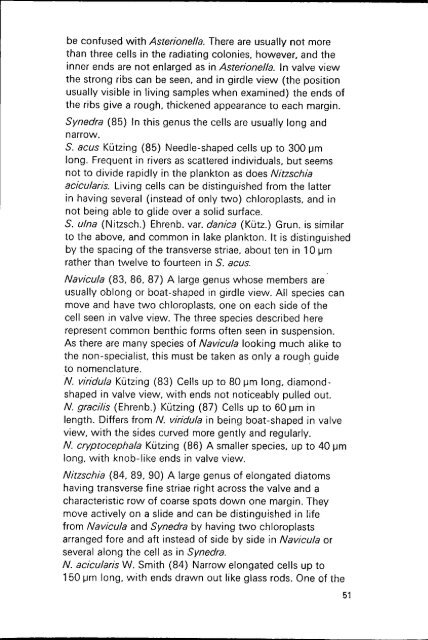Download (2189Kb) - NERC Open Research Archive - Natural ...
Download (2189Kb) - NERC Open Research Archive - Natural ...
Download (2189Kb) - NERC Open Research Archive - Natural ...
Create successful ePaper yourself
Turn your PDF publications into a flip-book with our unique Google optimized e-Paper software.
e confused with Asterione Ila. There are usually not more<br />
than three cells in the radiating colonies, however, and the<br />
inner ends are not enlarged as in Asterionella. In valve view<br />
the strong ribs can be seen, and in girdle view (the position<br />
usually visible in living samples when examined) the ends of<br />
the ribs give a rough, thickened appearance to each margin.<br />
Synedra (85) In this genus the cells are usually long and<br />
narrow.<br />
S. acus Kützing (85) Needle-shaped cells up to 300 pm<br />
long. Frequent in rivers as scattered individuals, but seems<br />
not to divide rapidly in the plankton as does Nitzschia<br />
acicularis. Living cells can be distinguished from the latter<br />
in having several (instead of only two) chloroplasts, and in<br />
not being able to glide over a solid surface.<br />
S. ulna (Nitzsch.) Ehrenb. var. danica (Katz.) Grun. is similar<br />
to the above, and common in lake plankton. It is distinguished<br />
by the spacing of the transverse striae, about ten in 10 pm<br />
rather than twelve to fourteen in S. acus.<br />
Navicula (83, 86, 87) A large genus whose members are<br />
usually oblong or boat-shaped in girdle view. All species can<br />
move and have two chloroplasts, one on each side of the<br />
cell seen in valve view. The three species described here<br />
represent common benthic forms often seen in suspension.<br />
As there are many species of Navicula looking much alike to<br />
the non-specialist, this must be taken as only a rough guide<br />
to nomenclature.<br />
N. viridula Kützing (83) Cells up to 80 pm long, diamondshaped<br />
in valve view, with ends not noticeably pulled out.<br />
N. gracilis (Ehrenb.) Kützing (87) Cells up to 60 pm in<br />
length. Differs from N. viridula in being boat-shaped in valve<br />
view, with the sides curved more gently and regularly.<br />
N. cryptocephala Katzing (86) A smaller species, up to 40 pm<br />
long, with knob-like ends in valve view.<br />
Nitzschia (84, 89, 90) A large genus of elongated diatoms<br />
having transverse fine striae right across the valve and a<br />
characteristic row of coarse spots down one margin. They<br />
move actively on a slide and can be distinguished in life<br />
from Navicula and Synedra by having two chloroplasts<br />
arranged fore and aft instead of side by side in Navicula or<br />
several along the cell as in Synedra.<br />
N. acicularis W. Smith (84) Narrow elongated cells up to<br />
150 pm long, with ends drawn out like glass rods. One of the<br />
51

















